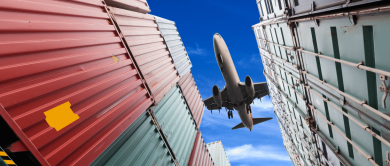“I want it now” Does this expression sound familiar? It increasingly fits the expectations of online shoppers, who follow the premise: “Why wait? If I can buy it from another store that can send it to me faster”. The delivery time users are willing to accept is getting shorter and shorter, which puts eCommerce in a frantic race against the clock, seeking to be competitive in their delivery times, while protecting their long-term profitability.
If you have an online store, you may have noticed that customer expectations about the speed and cost of shipping are increasingly demanding, but it was not always so, the needs of consumers have been changing over time.
When we were children, shipments that our grandparents requested letters or other products, took weeks or even months to arrive, because there was no infrastructure or technology to do it faster, therefore, it was common for people were willing to wait quietly to receive their messages or orders.
Would an end consumer expect so much today? The answer is no. The internet changed not only our way of producing and relating, it accustomed us to a culture of immediacy where most processes are carried out in an accelerated manner, a pace that we have taken to different aspects of our lives, where we want everything to be faster and more efficient, such as the delivery of a product purchased online.
What Is Fulfillment & Why Is It So Important?
How About These Figures!
- 53% of eCommerce users consider the speed of delivery of their product to be an influential factor in their purchasing decision.
- 38% will not purchase products again from a company with which they had a bad delivery experience.
- 61% will not even finish the purchase and abandon the cart if the shipping rates are too high.
What Is Fulfillment In Ecommerce?
Fulfillment is known as the process that includes: the reception, storage, assortment, packaging, and delivery of orders within an eCommerce, stages that are generated from the purchase are registered until the product is delivered to the customer, and the efficiency of each phase depends on the success of the delivery, now we will see why.
Fulfillment Process Step By Step
Step 0
Inventory up to date. Who knows what he has, knows what he can sell. Knowing with certainty how many pieces of a product you have and in which warehouse, that is, having proper inventory control and management is essential. The worst thing that can happen is to sell something you don’t have. The inventory must be updated in real-time to never fall into “out of stock” sales unless it is a pre-sale business strategy.
Order Generation
Once the customer enters your eCommerce and makes the purchase, an order is generated, from this moment the race against the clock begins, and the time you defined in your delivery promise starts to elapse.
Step 2
Efficient processing. The less the order is in the warehouse, the more value is added to the final customer because the delivery time is reduced. This stage plays a decisive role, the efficiency with which the preparation of the order is generated, depends on not generating assortment errors and how fast you can start transporting to the customer’s destination.
Step 3
On-time shipping. From your eCommerce to the customer’s door. Once the order has been processed and dispatched with the courier/parcel, the last mile process begins, this is where the customer receives their purchase and if there are no incidents, the delivery process culminates.
During this stage the issue of traceability is essential. Has it ever happened to you that you make a purchase and you don’t know where your order is or when it will arrive?
Communication with the end customer is one of the most important sales features of eCommerce, it is part of the shopping experience that the user has. Remember that you must be clear and transparent with the customer throughout the process, both in delivery times and in everything that happens after the transaction in your store.
As we can see, the 3 previous phases influence your fulfillment levels, your efficiency in each one will determine if you make your deliveries at a snail’s pace, or if, on the contrary, you are a fast and efficient roadrunner. To give you an idea of how the sector moves, the following graph shows how fast the deliveries of Mexican eCommerce are, where according to the study, 73% do it in a range of 48 to 72 hours.
In a smaller percentage, there are same-day deliveries, which, although they can be an attractive sales hook, are highly impossible for many eCommerce, due to the operational efforts they represent.
Step 4
Customer Service: the service does not end with the sale, after generating the e-commerce must be prepared to provide excellent after-sales service, where the customer is given traceability on their shipment, and their questions and needs are addressed.
Step 5
Timely returns: the ugly duckling of the sale! What eCommerce wants a product that has gone through the entire delivery process to be returned? Unfortunately, dissatisfied customers or certain conditions mean that returns can occur in any of your purchases, the important thing is to find the best way to deal with them, generating the least possible impact on your business.
Along with long delivery times, complicated return processes, are part of the criteria by which buyers qualify as negative their online shopping experience, have a procedure and always seek to generate “hero moments” to your end customer, always positively impact your level of sales.
Fulfillment Models: Which One Is The Best For Your Ecommerce?
Each eCommerce is different, both in its sales volume and in its growth projection and internal management, of these factors depend largely on the type of fulfillment that best suits your needs, among them we have:
In-House Fulfillment
It is when eCommerce assumes all the preparation functions on its own, that is, without hiring external services. The last mile, depending on the case, can be internal or external with parcels/messaging companies.
Pros: This model is an alternative to consider for those emerging online stores that are starting and do not yet have a high volume of orders, which can manage inventory and packaging manually, usually from their homes or stores, which allows them to save operating costs, but above all: learn from the business.
Cons: Fulfillment is a process that requires time and expertise, which is a valuable resource worth prioritizing in activities that increase sales. If the team spends a lot of time preparing orders, they will hardly be able to focus on making important decisions for the business, such as generating strategies to attract more customers.
Outsourced Fulfillment
As eCommerce businesses grow, they face two scenarios: outsourcing services or adapting their infrastructure, which do you think is the best option? What kind of companies do outsourcing these services apply to? If your business has grown and you have neither the time nor the infrastructure to cover the high demand of eCommerce, you should consider delegating these activities and focus on how to make your business continue to evolve.
Outsourcing is a good option and a worldwide trend for all eCommerce companies, you do not require investment and you save money (compared to the cost of your infrastructure), it also avoids operational wear and tear and gives you the time to dedicate to other business fronts.
Pros: you have unlimited operational capacity (not being internal), also, not having investment requirements, you will be delegating this work to an ally specialized in fulfillment and eCommerce that will give you the best practices from day 1, which will guarantee efficiency, quality of service and lower cost.
Cons: If you work with the wrong provider, that is, one that lacks experience and expertise in the field of fulfillment and eCommerce, the quality of your customer service may be affected. To prevent this from happening, it is important that before outsourcing your service, you make sure to hire a company that offers guarantees in this field, and which has the resources, technology, and experience to provide a satisfactory experience to your end consumer.
















